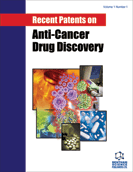
Abstract
Liver-related putative tumor suppressor(lpts) is a liver-related tumor suppressor candidate gene initially isolated by positional candidate cloning method. Three translation products of lpts gene are found, that are LPTS-L, LPTS-S and LPTS-M respectively. The gene highly expresses in normal tissues but lowly in cancer tissues. The LPTS proteins can suppress the activity of telomerase and trigger apoptosis for tumor cells in vivo and in vitro, despite that the detailed anti-cancer mechanism remains undefined. This review successively describes the lpts genomic assembly, transcriptional regulation and structure-activity evaluation of different LPTS isoforms; then it represents the LPTS binding partners, for example Pin2/TRF1 and MCRS2, which play important roles in decreasing telomerase activity, which benefits to reveal the anticancer mechanism; subsequently, it surveys several patents of recombinant LPTS proteins such as TAT-LPTS-LC, PinX1/C-G4S-9R-G4S-mBAFF and PinX1/C-9R-mBAF that can inhibit the growth of tumor cells. Lpts gene is becoming a promising drug target for cancer intervention owing to its powerful inhibition efficacy on telomerase activity, and recombinant LPTS proteins claimed by a couple of patents seem to be potential anti-cancer agents.
Keywords: Anti-cancer, liver-related putative tumor suppressor, Pinx1, Pin2/TRF1, telomerase, telomere.
Recent Patents on Anti-Cancer Drug Discovery
Title:LPTS: A Novel Tumor Suppressor Gene and a Promising Drug Target for Cancer Intervention
Volume: 10 Issue: 2
Author(s): Baichuan Li, Songshen Cao and Yunlai Liu
Affiliation:
Keywords: Anti-cancer, liver-related putative tumor suppressor, Pinx1, Pin2/TRF1, telomerase, telomere.
Abstract: Liver-related putative tumor suppressor(lpts) is a liver-related tumor suppressor candidate gene initially isolated by positional candidate cloning method. Three translation products of lpts gene are found, that are LPTS-L, LPTS-S and LPTS-M respectively. The gene highly expresses in normal tissues but lowly in cancer tissues. The LPTS proteins can suppress the activity of telomerase and trigger apoptosis for tumor cells in vivo and in vitro, despite that the detailed anti-cancer mechanism remains undefined. This review successively describes the lpts genomic assembly, transcriptional regulation and structure-activity evaluation of different LPTS isoforms; then it represents the LPTS binding partners, for example Pin2/TRF1 and MCRS2, which play important roles in decreasing telomerase activity, which benefits to reveal the anticancer mechanism; subsequently, it surveys several patents of recombinant LPTS proteins such as TAT-LPTS-LC, PinX1/C-G4S-9R-G4S-mBAFF and PinX1/C-9R-mBAF that can inhibit the growth of tumor cells. Lpts gene is becoming a promising drug target for cancer intervention owing to its powerful inhibition efficacy on telomerase activity, and recombinant LPTS proteins claimed by a couple of patents seem to be potential anti-cancer agents.
Export Options
About this article
Cite this article as:
Li Baichuan, Cao Songshen and Liu Yunlai, LPTS: A Novel Tumor Suppressor Gene and a Promising Drug Target for Cancer Intervention, Recent Patents on Anti-Cancer Drug Discovery 2015; 10 (2) . https://dx.doi.org/10.2174/1574892810666141205111913
| DOI https://dx.doi.org/10.2174/1574892810666141205111913 |
Print ISSN 1574-8928 |
| Publisher Name Bentham Science Publisher |
Online ISSN 2212-3970 |
 41
41 2
2 1
1
- Author Guidelines
- Graphical Abstracts
- Fabricating and Stating False Information
- Research Misconduct
- Post Publication Discussions and Corrections
- Publishing Ethics and Rectitude
- Increase Visibility of Your Article
- Archiving Policies
- Peer Review Workflow
- Order Your Article Before Print
- Promote Your Article
- Manuscript Transfer Facility
- Editorial Policies
- Allegations from Whistleblowers
Related Articles
-
Targeting Invasion Induction as a Therapeutic Strategy for the Treatment of Cancer
Current Cancer Drug Targets DNA Methylation: A Possible Target for Current and Future Studies on Cancer?
Epigenetic Diagnosis & Therapy (Discontinued) Synergistic Activity of the c-Met and Tubulin Inhibitor Tivantinib (ARQ197) with Pemetrexed in Mesothelioma Cells
Current Drug Targets Proteomics and Protein Analyses of Ovine and Caprine Body Fluids: Current Studies and Future Promises
Current Protein & Peptide Science Protein/Polyphenol Interactions: Past and Present Contributions. Mechanisms of Astringency Perception
Current Organic Chemistry Towards the Management of Inflammation: Recent Developments of mPGES-1 Inhibitors
Recent Patents on CNS Drug Discovery (Discontinued) Recent Advances in the Treatment of Interstitial Lung Disease in Patients with Polymyositis/Dermatomyositis
Endocrine, Metabolic & Immune Disorders - Drug Targets Revisiting Non-Cancer Drugs for Cancer Therapy
Current Topics in Medicinal Chemistry The Role of NPY and Ghrelin in Anorexia Nervosa
Current Pharmaceutical Design Rare Long-Term Complications Following Pancreaticoduodenectomy: Biliary and Pancreatic Lithiasis
Current Signal Transduction Therapy Chemoprevention of Cancers in Gastrointestinal Tract with Cyclooxygenase 2 Inhibitors
Current Pharmaceutical Design A Novel Model for Predicting LncRNA-disease Associations based on the LncRNA-MiRNA-Disease Interactive Network
Current Bioinformatics The Role of the Metabolism of Anticancer Drugs in Their Induced-Cardiotoxicity
Current Drug Metabolism Interstitial Lung Disease in Idiopathic Inflammatory Myopathy
Current Rheumatology Reviews MDM2 Increases Drug Resistance in Cancer Cells by Inducing EMT Independent of p53
Current Medicinal Chemistry <i>Hippophae salicifolia</i> D. Don, a Fascinating Medicinal Plant: An Update on its Traditional Medicinal Uses, Ethnopharmacology and Phytochemistry
Current Traditional Medicine A Novel Oncogenic Role of Disulfidptosis-related Gene SLC7A11 in Anti-tumor Immunotherapy Response to Human Cancers
Current Cancer Drug Targets Soft Computing Techniques for the Protein Folding Problem on High Performance Computing Architectures
Current Drug Targets Serum HE4 Level as a Biomarker to Predict the Recurrence of Gynecologic Cancers
Current Drug Targets NorA, Tet(K), MepA, and MsrA Efflux Pumps in <i>Staphylococcus aureus</i>, their Inhibitors and 1,8-Naphthyridine Sulfonamides
Current Pharmaceutical Design


























